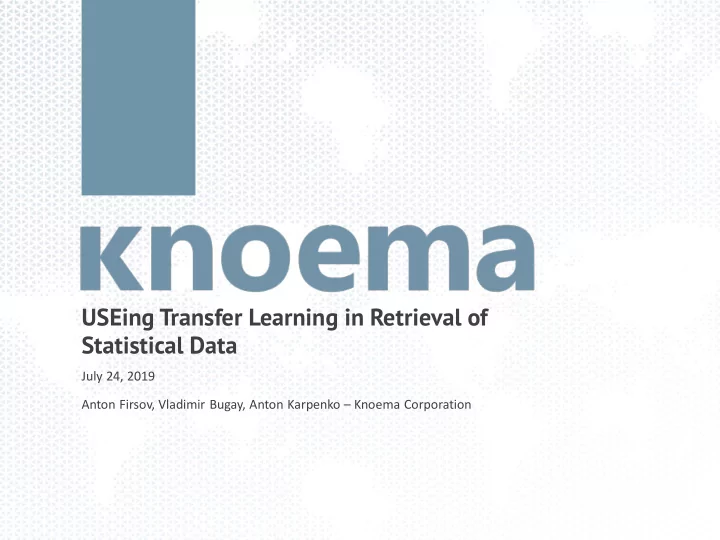

USEing Transfer Learning in Retrieval of Statistical Data July 24, 2019 Anton Firsov, Vladimir Bugay, Anton Karpenko – Knoema Corporation
INTRODUCTION ▪ Knoema is a global data aggregator and a search engine for data ▪ Our search operates with 3.2B time series which are mostly numbers with a limited textual metadata available ▪ More than 500K analysts and researchers look for data, facts and insights at https://knoema.com every month WHAT IS CHILD HOW MANY PEOPLE MORTALITY IN UGANDA LIVE IN PARIS? HOW MUCH MONEY IS SPENT ON RESEARCH IN USA 2
SPECIFICS OF OUR DOMAIN ▪ Narrow domain => less users => less data for training models ▪ Very short documents – time series ▪ Structure in the textual metadata (multiple fields aka dimensions, hierarchies) ▪ Complex queries for which only a collection of related time series can be an answer Uganda – Under-5 mortality rate Paris – Population (per 1,000 live births) United States – Basic Research Expenditures, Public Research, Million USD PPPs
COMPARISON QUERIES CHINA VS INDIA POPULATION
RANKING QUERIES COUNTRIES BY GDP PER CAPITA
PREVIOUS APPROACHES INVERTED INDEX + ONTOLOGY + PRE/POST PROCESSING ▪ Requires domain-specific ontology ▪ Problem with on-site data repositories ▪ A lot of heuristics and parameters => difficult to maintain DEEP STRUCTURED SEMANTIC MODEL (DSSM) [Huang et al., 2013] ▪ Small amount of click through data (~100K)
TRANSFER LEARNING USE BERT Full name Universal Sentence Encoder Bidirectional Encoder Representations from Transformers Authors [Cer et al., 2018] [Devlin et al., 2018] Model variation transformer-based base, uncased model for English language Underlying Transformer Transformer architecture Number of 6 12 attention layers Number of ~200M ~110M parameters Embedding size 512 768
ARCHITECTURE P(D|Q) Cosine similarity USE USE query document model model Query (Q) Document (D)
MODEL • ത 𝑅 = 𝑉𝑇𝐹 𝑅 𝑅 , where Q is the query and 𝑉𝑇𝐹 𝑅 - USE query model 𝐸 = 𝑉𝑇𝐹 𝐸 𝐸 , where D is the document (timeseries), 𝑉𝑇𝐹 𝐸 𝐸 - USE • ഥ document model 𝐸) – similarity between a query Q and document D • 𝑇 𝑅, 𝐸 = cos( ത 𝑅, ഥ To effectively calculate probability of document D given query Q we used negative sampling: − , where 𝐸 + is the document that was clicked • 𝐄 = 𝐸 + , 𝐸 1 − , 𝐸 2 − , … , 𝐸 𝑙 for query Q and 𝐸 𝑗 − - random unclicked documents exp(𝑇(𝑅,𝐸 + )) • 𝑄(𝐸 + |𝑅) = σ 𝐸′∈𝐄 exp(𝑇(𝑅,𝐸′)) • 𝑚𝑝𝑡𝑡 𝑅, 𝐄 = −log(𝑄 𝐸 + 𝑅 )
IMPLEMENTATION Click data Fine-tuning Finetuned BERT/USE model Embeddings Timeseries calculation Embeddings Indexing Index Search Query
TRAINING ▪ Training set ~13K click-through samples ▪ CV set ~2K click-through samples ▪ Adam optimizer with learning rate 1e-5 ▪ Batch size 32 (BERT) and 128 (USE) ▪ 4 negative samples per query ▪ 600 steps ▪ Training time <5 min on V100
EMBEDDING CALCULATIONS USE BERT • 400M timeseries • 400M timeseries • Calculated on V100 • Calculated on Google TPUv3 • ~8K timeseries per second • ~10K timeseries per second • Total time: ~14 hours • Total time: ~11 hours • Cost: ~32$ • Cost: ~90$ • Total size: ~900Gb • Total size: ~1.3Tb
INDEXING ▪ Using FAISS library [Johnson et al., 2017] for an approximate nearest neighbor search ▪ IVF index with 2^18 centroids and HNSW quantizer ▪ Centroids are trained on 25M random vectors (~5h on r5.2xlarge) ▪ Product Quantization with 32 and 16 components for index size reduction ▪ Total time to build index: ~10h ▪ Index size ~17Gb for PQ=32 and ~11Gb for PQ=16
RESULTS A/B test: mixed equal 3000 number of classic and USE results 2500 2000 Source of clicked Number of clicked results results 1500 USE 2791 Classic 2352 1000 Total 5143 500 18% HIGHER CTR 0 USE Classic
RESULT ANALYSIS AUTOMATICALLY DEDUCED SEMANTIC CLOSENESS ▪ Query: us gdp ▪ Result: United States - Gross domestic product, current prices (U.S. dollars) QUESTIONS IN NATURAL LANGUAGE ▪ Query: how many people live in paris? ▪ Result: Paris - Population RESULT GENERALIZATION ▪ Query: bmw theft in japan ▪ Result: Japan - Theft of Private Cars - Rate
WHAT’S NEXT COMPLEX QUERIES PROCESSING ▪ "china vs india population" ▪ "countries ranking by gdp" ▪ "world population density in 2017 on map" CHATBOT (DIGITAL RESEARCH ASSISTANT) • Need to keep context of the conversation • Difficulties with general questions RETRIEVAL OF STATISTICAL DATA RELEVANT TO THE TEXT (FACTFINDER) ▪ Multiple vectors per text ▪ Co-reference, ellipsis, anaphora, endophora resolution SUPPORT OF MULTIPLE LANGUAGES
CONCLUSION Finetuning of pretrained deep neural net models allowed us to: ▪ Improve the results of our search engine ▪ Decrease cost of ontology engineering ▪ Decrease resources cost (memory and CPU) ▪ Continuously, automatically and cost-effectively improve our search engine further using clickstream data ▪ Reduce codebase and simplify its maintenance However, some tasks such as complex query processing are still easier to solve with heuristics and some pre/post processing
THANK YOU FOR ATTENTION! QUESTIONS? ANTON FIRSOV AFIRSOV@KNOEMA.COM
Recommend
More recommend